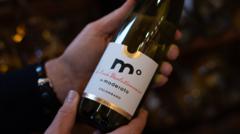In recent years, the acceptance and production of alcohol-free wine have dramatically changed in France, particularly in Bordeaux's vineyards. Once seen as an affront to tradition, wines devoid of alcohol are now becoming a viable product in the market. The shift is partially driven by scientific advancements in the production process and changing societal values, particularly among younger demographics who prioritize health and wellness.
Frédéric Brochet, a prominent oenologist in Bordeaux, shared his optimism about the alcohol-free wine revolution. Initially, attempts at producing these wines yielded subpar results, but improvements in the de-alcoholization process have made meaningful strides. Brochet's creation, the Moderato range, exemplifies this growth, marking a pivotal moment in the wine industry.
The recent opening of a wine shop in Bordeaux dedicated exclusively to alcohol-free wines highlights this transformative movement. Alexandre Kettaneh, the shop owner, reports an influx of inquiries from local wine-growers who wish to explore this market. This reflects the increasing recognition among traditional vintners that they must evolve to stay relevant.
Several factors have contributed to this movement: a declining domestic wine market, shifting consumption habits among youth, and advancements in production technology. Notably, the younger generation is less inclined to drink wine, with supermarkets allocating more shelf space to beer. Consequently, the alcohol-free segment now accounts for a significant portion of beer sales in France, mirroring a larger trend seen in countries like Spain.
Traditionally, alcohol-free wines were produced by boiling away alcohol and compensating with added flavors, which often resulted in inferior products. Recent innovations, such as low-temperature vacuum distillation and aroma preservation, have enhanced the quality of non-alcoholic wine, allowing them to reclaim the title of 'wine' rather than be labeled as mere beverages.
While the taste experience of alcohol-free reds differs from their traditional counterparts, oenologists assure consumers that the essential elements—such as bouquet, tannins, and balance—are still present. Coralie de Bouard, a wine estate owner, reported that around one-third of her sales are now attributed to non-alcoholic wines. After facing backlash for venturing into this market, her family's perspective has shifted, recognizing the necessity of adapting to consumer demands.
The conversation surrounding alcohol-free wine also touches on inclusivity. Advocates argue that it allows non-drinkers to participate in traditional wine-related activities without feeling excluded. As Anne Kattaneh noted, fostering a communal dining experience reminiscent of earlier times necessitates the inclusion of non-alcoholic options.
Brochet emphasizes that innovation is part of the wine industry’s evolution. He cites historical examples, suggesting that what was once considered revolutionary—like the introduction of barrels or corks—is now integral to the tradition. He argues that embracing alcohol-free wine could be essential for the sustainability of French vineyards, preserving both the cultural landscape and the industry itself.
In conclusion, the burgeoning market for alcohol-free wine in France is not just a niche trend; it represents a fundamental shift in how the wine industry adapts to evolving consumer preferences and embraces technological innovations.
Frédéric Brochet, a prominent oenologist in Bordeaux, shared his optimism about the alcohol-free wine revolution. Initially, attempts at producing these wines yielded subpar results, but improvements in the de-alcoholization process have made meaningful strides. Brochet's creation, the Moderato range, exemplifies this growth, marking a pivotal moment in the wine industry.
The recent opening of a wine shop in Bordeaux dedicated exclusively to alcohol-free wines highlights this transformative movement. Alexandre Kettaneh, the shop owner, reports an influx of inquiries from local wine-growers who wish to explore this market. This reflects the increasing recognition among traditional vintners that they must evolve to stay relevant.
Several factors have contributed to this movement: a declining domestic wine market, shifting consumption habits among youth, and advancements in production technology. Notably, the younger generation is less inclined to drink wine, with supermarkets allocating more shelf space to beer. Consequently, the alcohol-free segment now accounts for a significant portion of beer sales in France, mirroring a larger trend seen in countries like Spain.
Traditionally, alcohol-free wines were produced by boiling away alcohol and compensating with added flavors, which often resulted in inferior products. Recent innovations, such as low-temperature vacuum distillation and aroma preservation, have enhanced the quality of non-alcoholic wine, allowing them to reclaim the title of 'wine' rather than be labeled as mere beverages.
While the taste experience of alcohol-free reds differs from their traditional counterparts, oenologists assure consumers that the essential elements—such as bouquet, tannins, and balance—are still present. Coralie de Bouard, a wine estate owner, reported that around one-third of her sales are now attributed to non-alcoholic wines. After facing backlash for venturing into this market, her family's perspective has shifted, recognizing the necessity of adapting to consumer demands.
The conversation surrounding alcohol-free wine also touches on inclusivity. Advocates argue that it allows non-drinkers to participate in traditional wine-related activities without feeling excluded. As Anne Kattaneh noted, fostering a communal dining experience reminiscent of earlier times necessitates the inclusion of non-alcoholic options.
Brochet emphasizes that innovation is part of the wine industry’s evolution. He cites historical examples, suggesting that what was once considered revolutionary—like the introduction of barrels or corks—is now integral to the tradition. He argues that embracing alcohol-free wine could be essential for the sustainability of French vineyards, preserving both the cultural landscape and the industry itself.
In conclusion, the burgeoning market for alcohol-free wine in France is not just a niche trend; it represents a fundamental shift in how the wine industry adapts to evolving consumer preferences and embraces technological innovations.






















